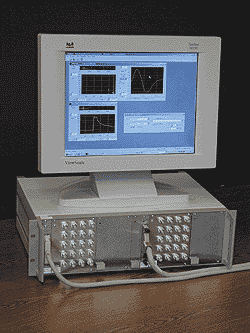

August 26, 2002
|

DAQ system provides objective pain measurement
A data acquisition (DAQ) system that has demonstrated the ability to provide objective measurements of different types of pain is facilitating basic research that may lead to more effective methods of pain relief. The DAQ system is used to study the peripheral nervous system by stimulating various neural receptors and measuring the resulting response. “By collecting between 3,000 and 30,000 samples per second, the new DAQ system makes it possible to measure signals that were too transitory to detect in the past,” says Brian Turnquist, a professor at Bethel College, Arden Hills, Minn., who is leading development of the device. Recently, it has been used to evaluate the response of nerves to capsaicin, the substance that makes chili peppers hot, and has been found to reduce pain in arthritis patients when topically applied as a cream. The latest research involves distinguishing between the effects caused by capsaicin on different receptors, particularly those that are sensitive to mechanical stimuli and those that are sensitive to heat. While capsaicin mainly affects heat-sensitive receptors, recent findings by researchers at Johns Hopkins Univ., Baltimore, show that it also affects some mechanically sensitive receptors that may lead to new applications for this drug. Capsaicin is the natural product of capsicum peppers that are the active ingredient in many hot foods. Capsaicin stimulates nociceptors—neurons that transmit information regarding tissue damage to pain processing centers in the spinal cord and brain—that results in the perception of pain. Pain is detected by two different types of peripheral nociceptor neurons, C-fiber nociceptors with slowly conducting unmyelinated axons, and A-fiber nociceptors with thinly myelinated axons. In general, A-fiber nociceptors produce a sharp or piercing pain while C-fiber nociceptors produce a burning or aching pain. Eventually capsaicin destroys certain nociceptors and reduces sensitivity to pain. One of the major advantages of capsaicin as a pain reliever is that it primarily inhibits heat pain but has much less effect on mechanical pain, leaving the patient free from numbness in most cases. For these reasons, the drug has been found to reduce pain in arthritis patients and also is used to treat the pain of herpes. As you might expect, capsaicin usually burns when it is first applied. It usually takes a few days for the pain relieving effects to kick in.
Different types of receptors Capsaicin weakly activates conventional C-fiber nociceptors, but produces a vigorous response in a subtype of C-fiber nociceptors that are insensitive to mechanical stimuli. Recently, researchers at Johns Hopkins School of Medicine and Johns Hopkins Applied Physics Laboratory studied the responses of A-fiber nociceptors to capsaicin. A-fiber nociceptors have been classified into three types based on their responsiveness to heat stimuli. Type I and II both consist of afferent nerves that carry impulses toward the central nervous system. Type I afferents are relatively insensitive to heat stimuli but respond with a long latency to intense, long-duration heat stimuli. Type II afferents are sensitive to heat and respond briskly to intense heat. The third type, high-threshold mechanoreceptive nociceptors, are unresponsive to heat stimuli. A crucial part of this and many other studies involves the measurement of electroneural data from the peripheral nervous system. One challenge is that neural electrical data of interest often lasts for less than a thousandth of a second, making it very difficult to detect and measure. In most cases, researchers want to stimulate the receptor with heat, cold, touch, or some other stimulus and measure the response—presenting another challenge. Only a few milliseconds normally elapse between the stimulus and response. The latencies in the Windows operating system are too high to deliver a stimulus and be certain of measuring the response. Over the past 10 years, Turnquist has been developing DAQ systems designed for synchronous control of stimulators and real-time acquisition and display of data. One of the keys to the success of these systems is the use of data acquisition processor (DAP) cards with onboard intelligence that can be programmed to deliver a stimulus and record the response without having to rely on the PC operating system. These cards can also acquire data at very high rates without concern about losing information when the PC operating system is occupied with other tasks. The DAQ processor system called DAPSYS was developed through the guidance and funding of the pain re-search group at Johns Hopkins and has been undergoing design, testing, revision, and enhancement for more than 15 years since its earliest ancestor that ran on a Digital Equipment Corp. PDP-11.
DAQ system operation The most recent version of DAPSYS combines a DAP 5200a/626 board from Microstar Laboratories, Bellevue, Wash., with a Pentium-based PC. The DAP board uses an AMD K6-III CPU within an architecture specialized for high-speed DAQ and processing. The DAP board is installed into one of the PCI slots and communicates with the PC resources through the PC bus. It runs its own real-time operating system and is a distinct computer within the physical confines of the PC chassis. The signal enters DAPSYS through the Microstar Industrial Enclosure, which provides standard BNC jacks for connection to laboratory equipment. The industrial enclosure also multiplexes the input data for input to the PC through two cables. On the back of the PC, cables running from the industrial enclosure connect to the analog and digital I/O connectors of the DAP board. The input signal enters the DAP board through its buffered input section and is then conditioned by various specialized routines and sent to the PC through the PC bus. The PC software displays and stores the data received from the DAP board. DAPSYS also provides stimulator control synchronized with the data collection. The DAP board runs the DAPL operating system designed by Microstar Laboratories for real-time DAQ and control. DAPL provides process latency control and buffering capabilities designed for data throughput and overrun prevention. The following routines execute concurrently whenever DAPSYS is operating: Input Process is an input routine written using standard DAPL commands that removes analog and digital samples from the input section of the DAP board and places them into buffered pipes for use by custom commands. The DAPDIGIO routine removes data from the digital in-put pipe and detects pulse and edge triggers. The DAPDISCR routine removes data from one of the analog input pipes and filters it using a threshold-window discrimination technique. The DAPSTIM process samples analog input at a constant rate of 25 kHz. The PC runs the Windows 2000 operating system, which provides a level of familiarity to the experimenter and also allows standard third-party post-hoc analysis tools to be used in conjunction with DAPSYS. Several DAPSYS applications are available that allow the experimenter to control and view the data being acquired by the DAP board, configure stimulator control, and do post-hoc experiment analysis. DAPSYS can control up to three stimulators simultaneously using either analog or digital control signals. The system provides analog input discrimination on two separate channels.
A hot study Johns Hopkins researchers displayed, recorded, and stored action potentials on a PC using the DAPSYS DAQ system DAPSYS allowed on- and off-line discrimination of different action potential waveforms based on multiple time-amplitude window criteria. In addition, the DAQ system controlled the laser that was used to apply heat stimuli to the skin and it recorded the corresponding skin temperature before, during, and after the stimuli. DAPSYS also was used to time the different phases of the injection protocol by providing an auditory signal at the appropriate time points to start the needle injection and the actual injection. Recorded action potentials were time-stamped, which allowed the time course and neuronal activity to be directly related to the manipulations that were performed. The results of the Johns Hopkins study show that all heat-sensitive A-fiber nociceptors were insensitive to mechanical stimuli but responded to the intradermal injection of capsaicin. Different receptive fields on the nociceptors were responsive to mechanical stimuli, thermal stimuli, and capsaicin. The majority of receptive field sites were responsive to only one or two of the three different types of stimuli while only eight sites responded to all three stimuli. For most heat-insensitive afferents, the activity induced by the capsaicin injection did not exceed the activity induced by needle insertion alone. However, the largest response to capsaicin injection was observed for five afferents that were insensitive to heat as well as mechanical stimuli. The report concluded that A-fiber nociceptors play a major role in the pain associated with capsaicin injection. “The ability to classify the response of different types of pain receptors to specific stimuli will almost certainly provide substantial assistance to researchers that are trying to find ways to reduce or eliminate pain that originates in the peripheral nervous system,” says Turnquist. “Measuring signals from the peripheral nervous system can provide an objective measurement of the signal that is sent to the brain by the different receptors, making it possible to more objectively measure the capabilities of different drugs in reducing pain. The DAQ card plays a key role in these measurements by providing onboard intelligence that makes it possible to apply a stimulus and measure the response that follows in less than a thousandth of a second.” —Jerry Fireman Fireman is president of Structured Information in Birmingham, Mich.
|
SPONSORS | |||||||||||||
|
Free Subscription | |||||||||||||||


